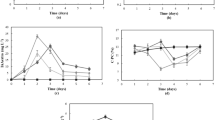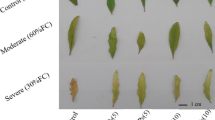Abstract
The effects of methyl jasmonate (MJ) and salicylic acid (SA) on changes of the activities of major antioxidant enzymes, superoxide anion accumulation (O2 −), ascorbate, total glutathione (TG), malondialdehyde (MDA) content and ginsenoside accumulation were investigated in ginseng roots (Panax ginseng L.) in 4 l (working volume) air lift bioreactors. Single treatment of 200 μM MJ and SA to P. ginseng roots enhanced ginsenoside accumulation compared to the control and harvested 3, 5, 7 and 9 days after treatment. MJ and SA treatment induced an oxidative stress in P. ginseng roots, as shown by an increase in lipid peroxidation due to rise in O2 − accumulation. Activity of superoxide dismutase (SOD) was inhibited in MJ-treated roots, while the activities of monodehydroascorbate reductase (MDHAR), dehydroascorbate reductase (DHAR), SOD, guaiacol peroxidase (G-POD), glutathione peroxidase (GPx) and glutathione reductase (GR) were induced in SA-treated roots. A strong decrease in the activity of catalase (CAT) was obtained in both MJ- and SA-treated roots. Activities of ascorbate peroxidase (APX) and glutathione S transferase (GST) were higher in MJ than SA while the contents of reduced ascorbate (ASC), redox state (ASC/(ASC+DHA)) and TG were higher in SA- than MJ-treated roots while oxidized ascorbate (DHA) decreased in both cases. The result of these analyses suggests that roots are better protected against the O2 − stress, thus mitigating MJ and SA stress. The information obtained in this work is useful for efficient large-scale production of ginsenoside by plant-root cultures.





Similar content being viewed by others
Abbreviations
- APX:
-
Ascorbate peroxidase (EC 1.11.1.11)
- CAT:
-
Catalase (EC 1.11.1.6)
- CBN:
-
Chungbuk National University Line 1
- DHAR:
-
Dehydroascorbate reductase (EC 1.8.5.1)
- DHA:
-
Dehydroascorbate
- GST:
-
Glutathione-S-transferase (EC 2.5.1.18)
- GPx:
-
Glutathione peroxidase (EC 1.11.1.12)
- GR:
-
Glutathione reductase (EC 1.6.4.2)
- G-POD:
-
Guaiacol peroxidase (EC 1.11.1.7)
- MDA:
-
Malondialdehyde
- MDHAR:
-
Monodehydroascorbate reductase (EC 1.6.5.4)
- NBT:
-
Nitroblue tetrazolium
- ROS:
-
Reactive oxygen species
- ASC:
-
Reduced ascorbate
- SOD:
-
Superoxide dismutase (EC 1.15.1.1)
- XTT:
-
Sodium,3,-[1-[phenylamino-carbonyl]-3,4-tetrazolium]-bis (4-methoxy-6-nitro) benzene-sulfonic acid hydrate.
References
Able AJ, Guest DI, Sutherland MW (1998) Use of a new tetrazolium-based assay to study the production of superoxide radicals by tobacco cell cultures challenged with avirulent zoospores of Phytophthora parasitica var nicotianae. Plant Physiol 117:491–499
Aebi H (1974) Catalases. In: Bergmeyer HU (ed) Methods of enzymatic analysis 2. Academic Press, New York, pp 673–684
Asada K (1999) The water-water cycle in chloroplasts: scavenging of active oxygens and dissipation of excess photons. Annu Rev Plant Physiol Plant Mol Biol 50:601–639
Beyer WF, Fridovich I (1987) Assaying for superoxide dismutase activity: some large consequences of minor changes in condition. Anal Biochem 161:559–566
Brader G, Tas E, Palva ET (2001) Jasmonate-dependent induction of indole glucosinolates in Arabidopsis by culture filtrates of the nonspecific pathogen Erwinia carotovora. Plant Physiol 126:849–860
Bradford MM (1976) A rapid and sensitive method for the quantitation of microgram quantities of protein utilizing the principle of protein-dye binding. Anal Biochem 72:248–254
Burhenne K, Gregersen L (2001) Up-regulation of the ascorbate-dependent antioxidative system in barley leaves during powdery mildew infection. Mol Plant Pathol 1:303–314
Chen GX, Asada K (1989) Ascorbate peroxidase in tea leaves: occurrence of two isozymes and the differences in their enzymatic and molecular properties. Plant Cell Physiol 30:987–998
Chen H, Chen F (1999) Effect of methyl jasmonate and salicylic acid on cell growth and crytotanshinone formation in Ti transformed Salivia miltiorrhiza cell suspension cultures. Biotech Lett 21:803–807
Chen Z, Silva H, Klessig DF (1993) Active oxygen species in the induction of plant systemic acquired resistance by salicylic acid. Science 262:1883–1886
Chong TM, Abdullah MA, Fadzillah NM, Lai OM, Lajis NH (2005) Jasmonic acid elicitation of anthraquinones with some associated. Enzyme Microb Technol 36:469–477
Creelman RA, Mullet JE (1997) Biosynthesis and action of jasmonates in plants. Annu Rev Plant Physiol Plant Mol Biol 48:355–381
Cummins I, Cole DJ, Edwards R (1999) A role for glutathion transferases functioning as glutathione peroxidase in resistance to multiple herbicides in black-grass. Plant J 18:285–292
De Gara L, Paciolla C, De Tullio MC, Motto M, Arrigioni O (2000) Ascorbate-dependent hydrogen peroxide detoxification and ascorbate regeneration during germination of a highly productive maize hybrid: evidence of an improved detoxification mechanism against reactive oxygen species. Physiol Plant 109:7–13
Delaney TP, Ukness S, Vernooij B, Friedrich L, Weymann K, Negrotoo N, Gaffney T, Gut-Rella M, Kessmann H, Ward E, Ryals J (1994) A central role of salicylic acid in plant disease resistance. Science 266:1247–1250
Doulis AG, Debian N, Kingston-Smith AH, Foyer CH (1997) Differential localization of antioxidants in maize. Plant Physiol 114:1031–1037
Draper J (1997) Salicyliate × superoxide synthesis and cell suicide in plant defense. Trends Plant Sci 2:162–165
Droter A, Phclps P, Fall R (1985) Evidence for glutathione peroxidase activities in cultured plant cells. Plant Sci 42:35–40
Ebel J, Mithöfer A (1998) Early events in the elicitation of plant defense. Planta 206:335–348
Ganesan V, Thomas G (2001) Salicylic acid response in rice: influence of salicylic acid on H2O2 accumulation and oxidative stress. Plant Sci 160:1095–1106
Griffith OW (1980) Determination of glutathione and glutathione disulfide using glutathione reductase and 2-vinylpyridine. Anal Biochem 106:207–211
Heath RL, Packer L (1968) Photoperoxidation in isolated chloroplasts. I. Kinetics and stoichiometry of fatty acid peroxidation. Arch Biochem Biophys 125:189–198
Hossain MA, Nakano Y, Asada K (1984) Monodehydroascorbate reductase in spinach chloroplasts and its participation in regeneration of ascorbate for scavenging hydrogen peroxide. Plant Cell Physiol 25:385–395
Hu X, Neill S, Cai W, Tang Z (2003) Hydrogen peroxide and jasmonic acid mediate oligogalacturonic acid-induced saponin accumulation in suspension-cultured cells of Panax ginseng. Physiol Plant 118:414–421
Jabs T, Tschope M, Colling C, Hahlbrock K, Scheel D (1997) Elicitor-stimulated ion fluxes and O2 − from the oxidative burst are essential components in triggering defense gene activation and phytoalexin synthesis in parsley. Proc Natl Acad Sci USA 94:4800–4805
Jung S (2004) Effect of chlorophyll reduction in Arabidopsis thaliana by methyl jasmonate or norflurazon on antioxidant systems. Plant Physiol Biochem 42:225–231
Kocsy G, Galiba G, Brunold C (2001) Role of glutathione in adaptation and signalling during chilling and cold acclimation in plants. Physiol Plant 113:158–164
Lamb C, Dixon RA (1997) The oxidative burst in plant disease resistance. Annual Review of Plant Physiology and Plant Molecular Biology 48:251–275
Lee MH, Jeong JH, Seo JW, Shin C-G, Kim YS, In G, Yang DC, Seon YJ, Choi YE (2004) Enhanced triterpene and phytosterol biosynthesis in Panax ginseng overexpressing squalene synthase gene. Plant Cell Physiol 45:976–984
Mittler R (2002) Oxidative stress, antioxidants and stress tolerance. Trends Plant Sci. 9:405–410
Mittova V, Guy M, Tal M and Volokita M (2002) Response of the cultivated tomato and its wild salt-tolerant relative Lycopersicon pennellii to salt-dependent oxidative stress: increased activities of antioxidant enzymes in root plastids. Free Radic Res 36:195–202
Mueller MJ, Brodschelm W, Spannagl E, Zenk MH (1993) Signaling in the elicitation process is mediated through the octadecanoid pathway leading to jasmonic acid. Proc Natl Acad Sci USA 90:7490–7494
Murashige T, Skoog F (1962) A revised medium for rapid growth and bioassays with tobacco tissue. Physiol Plant 15:473–497
Noctor G, Gómez L, Vanacker H, Foyer CH (2002) Interactions between biosynthesis, compartmentation and transport in the control of glutathione homeostasis and signaling. J Exp Bot 53:1283–1304
Pagila DE, Valentine WN (1967) Studies on the quantitative and qualitative characterization of erythrocytes glutathione peroxidase. J Lab Clin Med 70:158–169
Pütter J (1974) Peroxidases. In: Bergmeyer HU (ed) Methods of enzymatic analysis 2. Academic Press, New York, pp 685–690
Raskin I (1994) Role of salicylic acid in plants. Annu Rev Plant Physiol Plant Mol Biol 43:439–463
Scandalios LG (1993) Oxygen stress and superoxide dismutase. Plant Physiol 101:7–12
Smith IK, Vierheller TL, Thorne CA (1988) Assay of glutathione reductase in crude tissue homogenates using 5, 5'-dithiobis (2-nitrobenzoic acid). Anal Biochem 175:408–413
Suhita D, Raghavendra AS, Kwak JM, Vavasseur A (2004) Cytoplasmic Alkalization precedes reactive oxygen species production during methyl jasmonate- and abscisic acid-induced stomatal closure. Plant Physiol 134:1536–1545
Takahama U, Oniki T (1992) Regulation of peroxidase-dependent oxidation of phenolics in the apoplast of spinach leaves by ascorbate. Plant Cell Physiol 33:279–387
Tausz M, Šircelj H, Grill D (2005) The glutathione system as a stress marker in plant ecophysiology: is a stress-response concept valid? J Exp Bot 55:1955–1962
Wasternack C, Parthier B (1997) Jasmonate signaled plant gene expression. Trends Plant Sci 2:302–307
Yu DQ, Cen C, Yang ML (1999) Studies on the salicylic acid induced lipid peroxidation and defense gene expression in tabacco cell culture. Acta Bot Sin 41:977–982
Yu KW, Gao WY, Hahn EJ, Paek KY (2002) Jasmonic acid improves ginsenoside accumulation in adventitious root culture of Panax ginseng C. A Meyer Biochem Engg J 11:211–215
Yu KW, Hahn EJ, Paek KY (2000) Production of adventitious ginseng roots using bioreactors. Korean J Plant Tissue Cult 27:309–315
Zhao J, Hu Q, Guo YQ, Zhu WH (2001) Elicitor-induced indole alkaloid biosynthesis in Catharanthus roseus cell cultures is related to Ca2+ influx and the oxidative burst. Plant Sci 161:423–431
Zhao J, Lawrence CD, Verpoorte R (2005) Elicitor signal transduction leading to production of plant secondary metabolites. Res Rev Paper Biotechnol Adv 23:283–333
Acknowledgements
This work was financed by the Korean Science and Engineering Foundation (KOSEF) and BioGreen 21 project (RDA) through Research Center for the Development of Advanced Horticultural Technology at Chungbuk National University, Cheong-ju 361-763, Republic of Korea. This work was also financially supported by the Ministry Of Education and Human Resources Development (MOE), the Ministry of Commerce, Industry and Energy (MOCIE) and the Ministry of Labour (MOLAB), Republic of Korea through the fostering project of the Lab of Excellency.
Author information
Authors and Affiliations
Corresponding author
Additional information
Communicated by H. van Onckelen
Rights and permissions
About this article
Cite this article
Ali, M.B., Yu, KW., Hahn, EJ. et al. Methyl jasmonate and salicylic acid elicitation induces ginsenosides accumulation, enzymatic and non-enzymatic antioxidant in suspension culture Panax ginseng roots in bioreactors. Plant Cell Rep 25, 613–620 (2006). https://doi.org/10.1007/s00299-005-0065-6
Received:
Revised:
Accepted:
Published:
Issue Date:
DOI: https://doi.org/10.1007/s00299-005-0065-6




